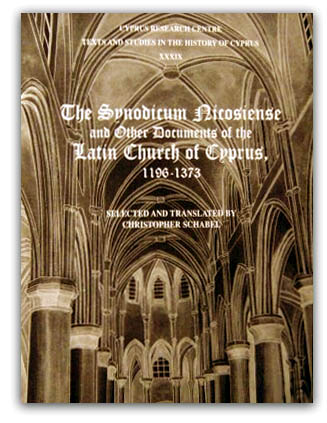| |

Luttrell,
Anthony - The Journal of Ecclesiastical History, Volume 54, Issue 02, April
2003, pp 319-389 - doi: 10.1017/S0022046903467237,
Published Online 13 May 2003
Edbury P W -
Review of 'The Synodicum Nicosiense and Other Documents of the Latin Church of
Cyprus, 1196-1373' (Editor C Schabel) in the English Historical Review
117(2002)1313-14 ISSN 0013-8266
In about 1340
Archbishop Elias of Nicosia compiled a collection of synodal decrees (or a
synodicum) relating to the ecclesiastical province of Cyprus and containing
material dating back to 1249 and the time of Eudes of Châteauroux, the papal
legate who accompanied St Louis’ crusade to the East. Elias’ successor,
Archbishop Philip, added a few more documents in the 1350s, and the entire
compilation was published by Philippe Labbe´ and Gabriel Cossart in their
Sacrosancta concilia ad regiam editionem exacta, Volume II (Paris,
1671).During the century that followed the appearance of this edition, the text
was reproduced in turn by Coleti, Hardouin and Mansi.
The manuscript
used by Labbe´ and Cossart seems, however, not to have survived. Christopher
Schabel has now reprinted the Latin text from the Labbe´–Cossart edition and
provided a parallel translation into English. More than that, he has translated
sixty-one other documents, mostly papal letters, relating to the Latin Church in
Cyprus, and its relations with the Greeks. The Latin province in Cyprus had been
established in the 1190s following the conquest of the island by Richard the
Lionheart during the Third Crusade, and it lasted until the Ottoman conquest in
1570–1571. An archbishop of Nicosia was assisted by suffragans at Paphos,
Limassol and Famagusta, and the surviving cathedrals at Nicosia and Famagusta
testify to hierarchy’s wealth and power. The majority of the population,
however, remained loyal to the orthodox rite. It would seem that for almost
thirty years after the initial conquest the Latins did little to bring the
Greeks into ecclesiastical subjection, but, beginning in the early 1220s, the
Greek bishops, now reduced in number to four, were forced to become coadjutors
of the Latins, and, though allowed to retain their Greek rite and customs, they
were obliged to acknowledge papal supremacy and accept the status of uniates.
Not surprisingly many Greek clergy were violently opposed to these changes, and
the synodal decrees and papal letters provide striking testimony from the Latin
side of the relations between the two confessions until the third quarter of the
fourteenth century.
It is a story
of bitter disputes, exacerbated on the Greek side by the fact that, whereas some
Greek clergy were implacably opposed to subordination to the Latins, others seem
to have been prepared to co-operate and even take their disputes to the papal
curia.
This is a most
useful collection, and Dr Schabel is to be congratulated on providing a text and
translations that, besides shedding much light on the Latin Church and its
dealings with the Greeks on Cyprus, ought to stimulate interest in relations
between western and eastern churches elsewhere.
PW Edbury,
University of Cardiff.
|